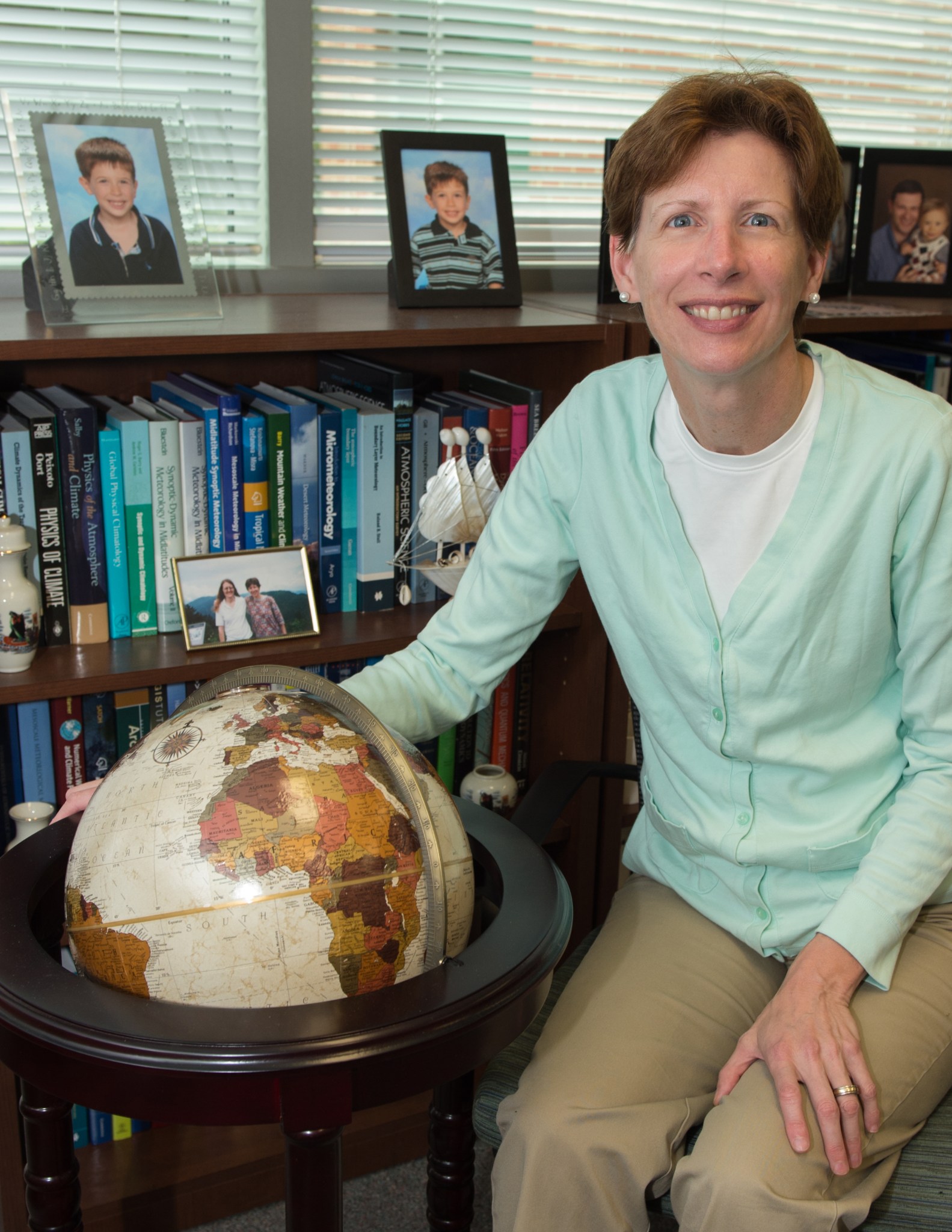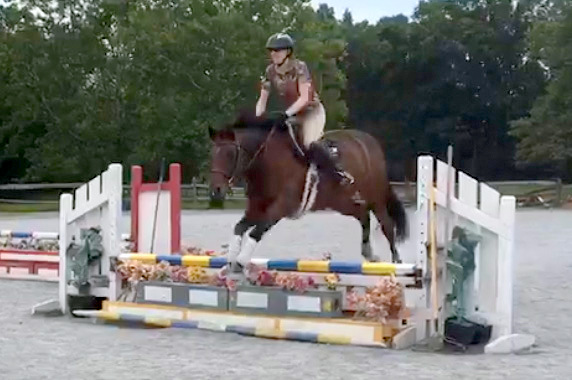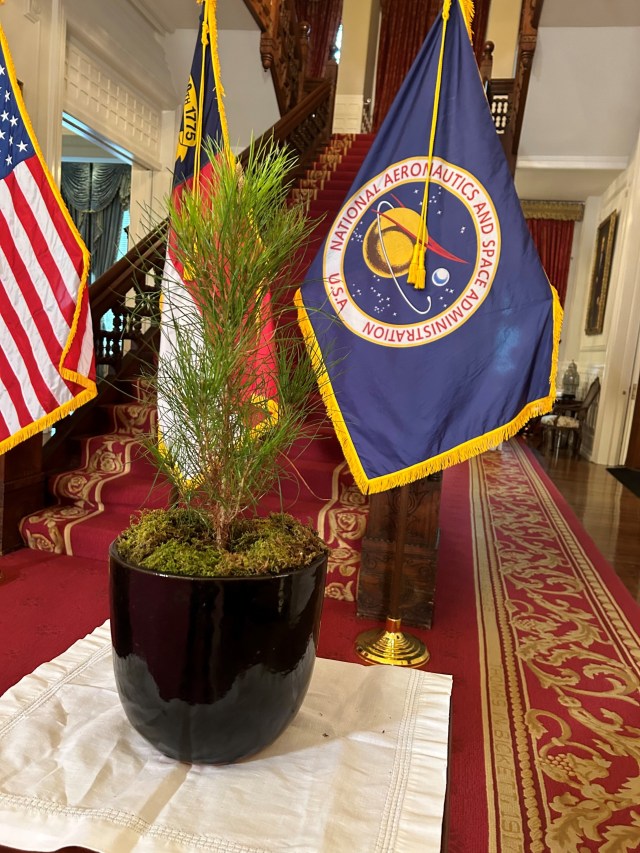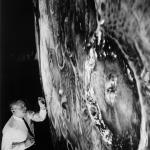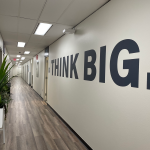Name: Karen Mohr
Formal Job Classification: Associate Deputy Director for Atmospheres
Organization: Code 610, Earth Science Division – Atmospheres, Earth Science Division, Science Directorate, Office of the Director
What do you do and what is most interesting about your role here at Goddard? How do you help support Goddard’s mission?
I provide day-to-day support for the operations of the atmospheric science labs. I help manage budgets, travel, IT security, hiring, technical equipment, personnel actions and training. Atmospheric sciences at Goddard has 300 people in three labs and a field station. We are all a big family.
I am an active atmospheric scientist with a specialty in hydrometeorology. I study the formation of clouds and precipitation in arid regions. I am particularly interested in the precipitation variability of West Africa. Everything I do is based on remote sensing of clouds and precipitation from satellites.
I have been in this position two-and-a-half years. I have been at Goddard since 2009.
What is your supervisory style?
I think it is important to make expectations clear and then give people some freedom to meet those expectations. I do not want to be a micromanager. I think people like to try to do things their own way and they like knowing that I prefer this approach too.
I have an open door. I stop and speak to people in the hallways and ask them how they are doing.
I also let people know that that they can come to me as soon as problems develop. I want to hear about problems early so that we can do something about them before they become serious. When someone has a problem, I want to know what is happening Then my next thought is what we can do to fix this? I balance my reaction against the urgency of the problem.
Also, I try to model the behavior that I would like to see in those I supervise. I know how frustrating it is when supervisors do not practice what they preach. My goal as a supervisor is to help people move forward in their work and careers.
What was your path to becoming an atmospheric scientist?
I came to this profession in a rather roundabout way. I was an undergraduate physics major at the College of the Holy Cross in Worcester, Massachusetts. I joined the Air Force while in college. After graduation, the Air Force assigned me to the Air Weather Service and I spent the next year studying meteorology at Penn State. The Air Force then assigned me to Travis Air Force Base near San Francisco as an aviation meteorologist. I made forecasts for Air Force bases and Air Force missions around the Pacific Rim. That is where I got my start as a meteorologist.
I served five years in the Air Force and then took a civilian job as a wind energy meteorologist in the San Francisco area. I analyzed wind turbine production data versus wind availability. I compared how the turbines performed relative to the winds that occurred, that is, power production versus wind speeds. If a turbine underperformed relative to the wind availability, it was usually a mechanical problem with a turbine.
After a couple of years in the wind energy industry, I went to Texas A&M for graduate school to study tropical meteorology. After obtaining my master’s degree in atmospheric science, I decided that I preferred to study Earth system science, so I transferred to the University of Texas in Austin. I had the best time of my life there! Austin is an exciting city with a lot of outdoor activities. I earned my doctorate with a concentration in hydrology.
Where did you work after you got your doctorate?
From 2000 to 2008, I was a professor of atmospheric science in the Department of Atmospheric and Environmental Science at the University at Albany, State University of New York (SUNY Albany). I taught graduate and undergraduate courses, mentored graduate students, and conducted my own funded research program in hydrometerology.
My work at SUNY Albany further developed me as a supervisor. I learned a lot about teaching and working with students as well as how to run my own research program.
What are the differences between academia and Goddard?
I love being here! Ultimately, I found that academia was too isolating an existence for me. When I was at the university, I worked with satellite data. But I wanted to actually work on the satellite programs, which is what I now do. I prefer being in an environment where teamwork and mission are the goals. I enjoy being around other people who are also focused on the satellite programs. I like being part of a team.
When your supervisory duties permit, are you still conducting research in atmospheric physics?
My primary responsibility is the day to day management of our atmospheric science labs. When I am not actively working on a budget or personnel issue, I make time to analyze satellite data from NASA and NOAA satellites. I also compare what I see in the satellite imagery to radar and rain gauge data on the ground. My end product is a map showing areas where strong storms are forming so that we can try to understand the conditions in the atmosphere and the soil that might produce those strong storms through modeling. I used to do the modeling myself, but now I tend to use publicly available model results.
My life’s work as an atmospheric scientist has been to bring together everything I learned in two graduate schools to research the atmospheric side of the global water cycle which includes the atmospheres, the oceans and the land. The work I do gives us a better understanding of cycles of drought and excessive precipitation in areas vulnerable to both.
My research work not only satisfies my personal curiosity about atmospheric physics, but also keeps me in touch with developments in the field relevant to our atmospheric labs. Our lab scientists want to know that I understand and face the same issues that they do.
How is science a team sport?
We have to have a play book, rules and team mates who support each other. We all need to work together to get the ball across the goal line. Our program scientists are our coaches who guide and support us.
We all have the same goal, which is to get the satellite off the launch pad and operational with data products flowing to users all over the world. This is not an individual endeavor, it requires a team from Goddard partnering with teams from other government agencies and universities from around the world.
What was your professional turning point?
As a child, I knew that I wanted to become a scientist, but I was not fixated on a particular discipline. The Air Force settled the issue for me when they sent me a letter assigning me to Air Weather Service. That was the turning point in my professional life.
All my life, I have dealt with whatever has come my way as best I could. I have also taken advantage of any opportunities offered to me such as joining the Air Force and coming to Goddard. I am very flexible which has allowed me to see the good in interesting situations.
Why is flexibility important in a scientist?
I mentor young scientists in atmospheric science. I encourage them to be flexible, to keep their ears and eyes open to see how the field is changing and evolving, and adjust to meet those changing circumstances. The scientific world evolves and we as scientists have to evolve with it.
When I was in graduate school at Texas A&M, I felt that the scientific world was moving away from rigid disciplinary boundaries and towards an integrated Earth system science view. That is why I changed fields and switched schools. My choices show that I practice my own advice.
Who at Goddard have inspired you and how?
The late Joanne Simpson was a Goddard chief scientist and is the closest we have to the mother of tropical meteorology. She was the first woman to get a doctorate in atmospheric science in the United States and she revolutionized our understanding of tropical atmospheric circulations. She mentored my mentor so I feel that I knew her and admire her. Her papers are still being cited.
I also look up to Wei-Kuo Tao, an atmospheric scientist. He helped me with my research in graduate school, gave me career advice as I launched my career, provided references and encouraged me to apply to Goddard. I talk to him every week. We are very close. He is still producing ground-breaking research after 30 years at Goddard and yet makes time for me and others he mentors.
How are scientists linked together?
Scientists pay it forward. Every scientist knows that we are responsible for training the next generation of scientists just as those before us trained us. We look after each other for the duration of our careers. We may not know each other personally, but we are linked by our research interests. We challenge each other’s work to make the field better.
Scientists are also linked to those who support science at Goddard such as our resource analysts, administrative assistants, procurement specialists and lab managers. I enjoy working with our support staff. I respect how they contribute to making science possible at Goddard.
Is there something surprising about you that people do not generally know?
I have two hobbies. I have an active fitness program that includes running and Pilates. I also enjoy horseback riding. I have a German-import, Oldenburg mare named Glow. Oldenburgs are a large, old German breed that specialize in jumping and dressage. I have trained Glow in dressage, and I show her in the hunter jumper classes at local horse shows.
What is your “six-word memoir?” A six-word memoir describes something in just six words.
Curious. Dedicated. Loyal. Hardworking. Flexible. Adventurous.
By Elizabeth M. Jarrell
NASA’s Goddard Space Flight Center, Greenbelt, Md.

Conversations With Goddard is a collection of Q&A profiles highlighting the breadth and depth of NASA’s Goddard Space Flight Center’s talented and diverse workforce. The Conversations have been published twice a month on average since May 2011. Read past editions on Goddard’s “Our People” webpage.





























